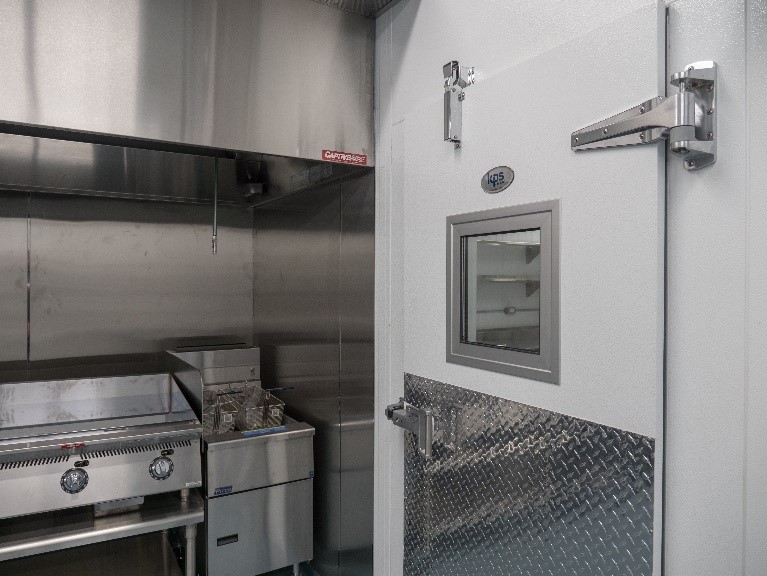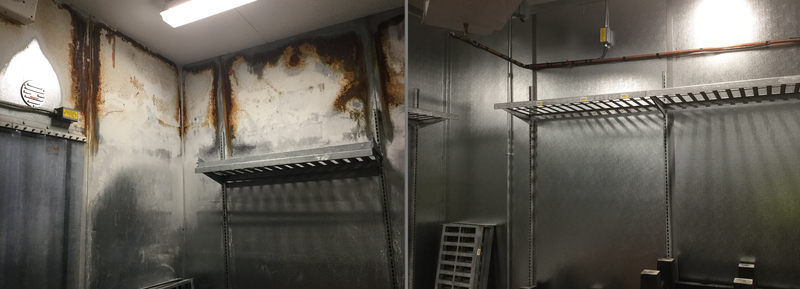A forum for contributed pieces from industry thought leaders, retailers, wholesalers and manufacturers. The views expressed are those of the authors.
Should that worn-out walk-in cooler be repaired or replaced?Should that worn-out walk-in cooler be repaired or replaced?
Normal daily wear and tear cause a walk-in to work harder than necessary. Here’s a handy guide to replacing or repairing coolers and freezers

Jason Bratcher is the Senior Manager of Project Management at KPS Global, a leader in the cold storage industry. The views expressed here are those of the author.

Walk-in coolers and freezers are expensive, yet vital, pieces of equipment that take a lot of “heat,” so to speak. Normal daily wear and tear, environmental conditions, impact by carts or pallet jacks, condensation and icing can cause a walk-in to work harder than necessary.
When this happens, operators often wonder: should the worn walk-in be repaired or replaced entirely?
The decision to repair or replace a walk-in cooler isn’t always straightforward, as many factors go into making the choice at the appropriate time.
When to Repair Your Walk-In
Suppose your walk-in is working, but not at peak performance. Perhaps it does not maintain temperature, ice has caused panel joints to displace, or the panel finish is beginning to corrode because of spills. Or maybe replacement is not an option because of budget constraints, commodity price increases, supply chain shortages or scheduling limitations.
Some issues may be easily remedied to avoid shutdowns, as full replacements typically require.
Below is a list of situations in which repairs can be made to your walk-in:
The door is not closing. In this case, simply adjusting or replacing the door hardware is a low-cost way to address the issue. A walk-in cooler’s doors and hinges take most of the wear and tear. After all, you open the door every time you take something out or place something inside.
There is ice or condensation on the door frame of your walk-in freezer. When this happens, a simple fix is typically all that is necessary — replacing the door heater or checking the connections to the door heater will likely do the trick.
Condensation, frost and ice are building up on your panel joints or the joints are swollen or displaced. These issues form when water vapor penetrates through openings or cracks from the outside and eventually cause panel joints to swell and separate, ultimately causing damage and increasing operating costs. This issue can be resolved with the application of batten strips, which are engineered to reseal panel joints and increase longevity.
You notice puddles or ice on or near your walk-in. Water leakage usually signals a problem with the inner sealing of the door or panel joints.
Your unit is making loud or unusual noises. This is most often due to an issue with the condenser. Walk-in coolers use condensers to keep the unit at the optimal temperature, which prevents spoilage of products. Installing a new refrigeration system could solve this issue.
There is white rust or slight corrosion on panels. This can be addressed by reskinning the interior or by applying liner panels. Liner panels can add up to five years of lifespan to your walk-in and increase the insulative properties of your walk-in panels.
You have minor damage to a panel. In this case, a patch or replacement of only the affected panels is an easy solution.
The freezer floor is heaving due to water getting under the walk-in and freezing. In this case, a floor replacement would be possible. The floor is easy to replace: you could either drop in a new floor out or lay a new one over the top of the existing floor.

Above, a before-and-after look at the liner panels of a walk-in cooler. Liner panels can add up to five years of lifespan to your walk-in and increase the insulative properties of your walk-in panels.
When to Replace Your Walk-In
Not all repairs will completely resolve the issues at hand, meaning there will likely come a time where a replacement is essential.
Putting off purchasing a replacement walk-in may result in a sudden breakdown that catches you unprepared, affecting cold storage functionality, customer relationships and profits.
New units offer more energy efficiencies as new panels have better insulative properties and higher R-values. In other words, they have the ability to resist energy to flow through them. Having a high R-value is critical since walk-ins constantly fight to keep warm air and humidity from making their way into the unit, ultimately compromising the unit’s operational abilities. Using less energy will save operators money in the long run.
Here is a list of scenarios in which replacement makes sense:
The panel joints have opened up too far or separated too much for repair.
Panel walls are bowing, or the ceiling is caving in.
Existing panels are not meeting current energy codes.
Exterior panel joints are sweating. In some ambient conditions the combination of temperature and high humidity is such that having wood-framed panels or inadequate R-value can be the cause. It will be beneficial to move to a frame type and/or thicker panels that are designed to operate in those kinds of conditions.
Making the Call
Preventative measures, such as conducting routine inspections and maintaining humidity levels surrounding the walk-in, can be taken to not only extend the unit’s longevity but also uphold its ability to operate at normal capacity.
However, as issues arise it is important to address them as quickly as possible. Problems can start out small and develop rapidly.
Repairing where possible will save you money. However, if the cost of your repairs is mounting, it might be worth investing in a new unit.
To sum it up, when making the decision to repair or replace your walk-in cooler or freezer, consider the age of your unit, the cost of repair versus replacement, the temperature consistency of your system, the amount of energy and the frequency of your preventative maintenance. Once you’ve checked all these boxes, you can make your decision with confidence.
About the Author
You May Also Like






